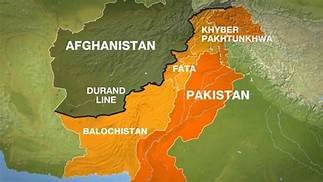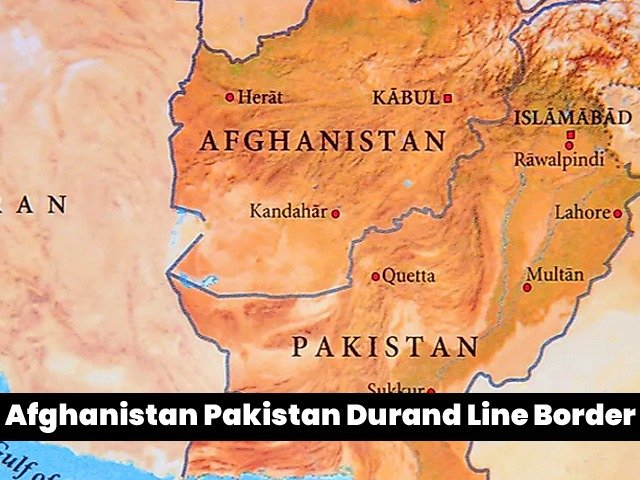Amid the 2021 Taliban offensive, another issue that is attracting the attention of policy makers is the Durand Line and its impact on peace and stability in Afghanistan.

Durand Line
The Durand Line, carved in 1893, artificially divides the Pashtun-dominated regions of Afghanistan and Pakistan in South Asia.
2- It was created under the then British colonial administrator Sir Henry Mortimer Durand through an agreement with Abdur Rahman, the then Emir of Afghanistan. The settlement comprises a vast stretch of land of more than 1519 miles which is of strategic importance.
3- Its western end goes to Iran while the eastern end is in western China and since the 1980s has been one of the most dangerous borders in the world due to smuggling and terrorism.
4- The Durand Line is internationally recognized as the western border of Pakistan but is not recognized by Afghanistan.
5- Pakistan is partly responsible for peace and stability in Afghanistan because it aids and promotes terrorist groups operating around the border shared by the conjoined twins.

Durand line problem
The Pashtun-led Taliban has never recognized the Durand Line between Afghanistan and Pakistan and has caused trouble among neighbors since 1947.
Recently, Pakistan has started unilaterally fencing the Durand Line, causing a lot of ruckus in Afghanistan, both at the government and public levels.
With the Taliban’s swift militant victory over Afghanistan, Pakistan wants the Taliban to accept the border, which, in turn, will give it a strategic advantage in the long run.
Historical Origin of Durand Line
The Durand Line dates back to the late 19th century and can be attributed to the complex geopolitics prevalent in Afghanistan due to imperialist proposals from both Tsarist Russia and the colonial British administration of India.
Both Russia and the US wanted to have more control over Afghanistan keeping in mind their respective strategic interests. At the same time, the Afghan rulers also wanted to maintain their autonomy.
To counter Russian advances, the British colonial administration regarded Afghanistan as a buffer and its border with Central Asia as a border.
The growing infiltration of Russian goods into Afghanistan by the then British colonial administration in India, as well as a heavy Russian military presence in the vicinity of northern Afghanistan, gave rise to apprehensions.
British colonial administrator Sir Henry Mortimer Durand gave some of the reasons that prompted the colonial British administration to move to Afghanistan.
1- The Advancement of Russia in Central Asia.
2- The Afghans lost faith in Russia and agreed not to deal with foreign powers.
3- The Kurram Valley was captured by British forces, providing an alternative route into Afghanistan.
Although the British controlled the Kurram Valley, there was a need to protect its administration and India’s border from both foreign European powers and tribal raids in the late 19th century.
These aforementioned strategic imperatives prompted the British colonial administrator to conclude a negotiation with Afghanistan to create a buffer zone in 1893, known as the Durand Line Agreement.
Durand Line Legal Status
The delimitation of the actual border between Afghanistan and India was one of the major legal implications of the above agreement.
As part of the agreement, the then Emir of Afghanistan retained his position in Wakhan, Asmar District and Wazir District. Concurrently, he agreed to relocate Pashtun-dominated areas, including Swat and Chitral.
Several studies have suggested that the Durand Line is legally void, thus, after 1947, Pakistan has no right to control the territories that Afghanistan considers its own.
Some of the reasons why the Durand Line is not legally binding on Afghanistan are given below:
1- Signed between the Emir of Afghanistan and the then colonial British administration in India, the treaty has not been ratified by any legislative body of either party.
2- It was not an internationally recognized border but a de facto arrangement keeping in mind the geopolitical developments of the time.
3- In 1921, a document was signed by Afghanistan and the British colonial administration, providing three-year terms for the treaty and its repeal, provided both parties agree.
4- The British colonial administration forcibly signed the treaty in 1893 and any law signed under coercion is invalid under international law.
Relevance of Durand Line in the present context
Although the agreement was signed, the Afghans were unhappy with it as the regions given to the British were arbitrary in nature. Additionally, the people of these regions were Pashtuns and Afghanistan had itself originated from this region, and redrawing of territories led to the weakening of the identity of people as they were cut off from their roots and the rest of the community.
Relevance of Durand Line in the present context
Although the agreement was signed, the Afghans were unhappy with it as the territories given to the British were arbitrary in nature. Additionally, the people of these regions were Pashtuns and Afghanistan itself originated from the region, and the rediscovery of regions weakened the identity of the people as they were cut off from their roots and the rest of the community.
Amir acknowledged the grave mistake he had committed by signing the agreement and the local people also expressed their displeasure against the Durand Agreement.
Since Afghanistan is a landlocked nation, it is unable to access the sea through Balochistan as the Durand Agreement carved out most of the territories that are now part of Pakistan.
After 1947, there has been a growing demand for annexation of Pashtun-majority areas into Afghanistan as Pakistan has no right to keep Pashtun-dominated areas under its control.
In a tweet on the Durand Line, Amrullah Saleh said, “No Afghan politician of national stature can ignore the Durand Line issue. It will condemn it in life and in the afterlife. This is an issue to be discussed.” And solutions are needed. It is unrealistic to expect gifts from us for free. Peshawar used to be the conquering capital of Afghanistan.”
